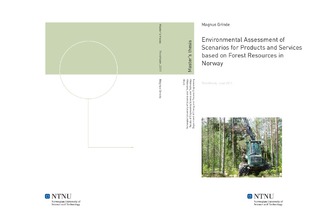| dc.description.abstract | Energy from wood biomass is one of the prioritized areas of focus in current Norwegian energy politics. The prevailing perception of bioenergy is that it is climate neutral, making this strategy appear to be an effective measure in combating climate change. Furthermore, bioenergy is considered to be relatively source of energy, and steadily increasing Norwegian forests imply huge amounts of wood available. However, not all of this wood is easily accessible with current technology and market situations (i.e. prices). As wood also is used for many other purposes, mainly construction and paper production, the bioenergy industry will have to compete with these other industries for the access to raw materials. A change in current utilization of our wood resources is in this thesis assessed in an environmental perspective in order to better understand how such a shift would influence the overall environmental impacts. First, a wood flow mapping of the current (2006) situation was carried out and applied in a ‘hybrid life cycle assessment’ model utilizing life cycle inventories which represent the industries within the Norwegian wood products sector. Then, an alternative wood flow scenario where more wood were used for bioenergy purposes, at the expense of reduced domestic paper- and wood panel production, was studied. Besides from being highly representative for Norwegian conditions, the model was developed with the intention of being able to show the breakdown of environmental impacts for both for entire sector as well as for specific products and industries. Furthermore, in contrast to the current dominant perception, recent research has pointed to the fact that the resulting greenhouse gas emissions from combustion of biomass will have a significant climate change impact even if new biomass is replanted immediately, as the gases will spend a considerable time in the atmosphere before being absorbed. This new insight may seriously influence the perceived effectiveness of bioenergy in climate change mitigation efforts. Consequently, it was considered valuable to include estimated climate change impact potentials of biogenic carbon emissions (CO2 and CH4) in this assessment. Although the developed model probably should be further refined before ultimate conclusions are made based on the assessment results, some important observations can be commented. First of all, it was clearly shown that whether or not climate change impacts from biogenic carbon emissions are considered is highly relevant to the overall climate change mitigation effect of bioenergy. Still, even when these are included there are considerable environmental gains when e.g. substituting fossil energy with wood-based bioenergy. Secondly, the results illustrate how impacts from different environmental impact categories are distributed within the wood products sector (pulp & paper production clearly being the dominant industry), within the products’ value chains and for the overall system (characterized by the impacts from paper- and heat production as well as the use of transportation fuels). | nb_NO |

